Funny Keep the Cat in the House Sign

Top reasons your cat is angry
Cats can't speak, but that doesn't mean they can't communicate, and they're always trying to tell you something, says Dawn Kavanaugh, cat behaviorist and CEO of All About Animals Rescue. Whether they're happy or sad, in pain, or particularly when they're a little ticked off, they want you, their favorite human, to know it.
Your cat may make angry cat noises, seemingly purposefully knock something over, or pee on your new bedspread. Instead of instantly reacting, play detective, says Kavanaugh. Out-of-character cat behavior may be a sign of cat anxiety, cat depression, or something else.
"Your cat needs you to be watching and listening to what it tells you," she says. "You have to figure out what the kitty is trying to say—and perhaps kitty is saying it's angry or upset." A cat's body language can also hold a number of clues to how it's feeling.
As for why your cat is angry, chances are it's afraid, feeling territorial, having a conflict with another cat or a dog, or in pain.
We asked cat behavior experts to share the subtle signs of how your angry cat may show anger. But remember, no matter how your cat is feeling, you, as their human, should always respond with love and patience.
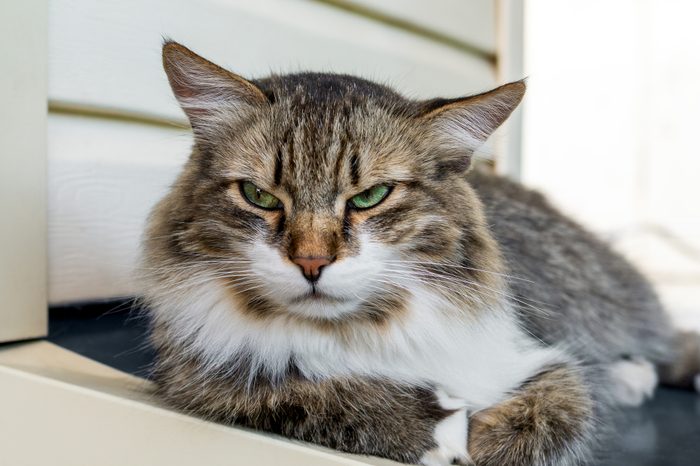
She watches you from afar
It can be hard to tell if your cat is keeping her distance because she's upset, or if she's staying away because, well, she's a cat and cats are weirdos. But if your furry friend actively avoids you when she's normally playful or keeps away for longer than usual, it can be a sign she's mad, scared, or anxious, says Michael Rueb, cat behavior expert and operations manager for the National Cat Protection Society. Angry cats will keep their distance when they get confused by, say, a sudden loud voice, quick movements, or even an unfamiliar smell on your jacket, he explains. The solution? Let her have her space—she'll come back when she's ready.
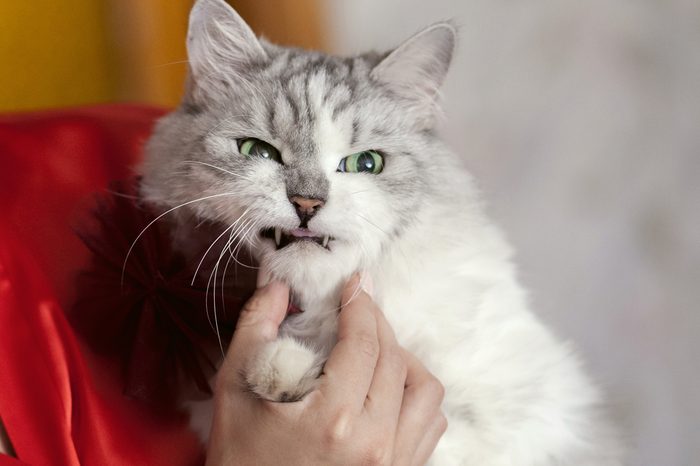
He growls at you
Think it's just dogs that growl? Then you've never seen an angry cat or fighting cats. Angry cats can make a wide variety of noises that signal their displeasure, including a throaty growl, Rueb says. If your bestie is vocalizing his feelings, start by giving him his space and then slowly do things that will create a positive relationship, like feeding, playing with toys, grooming, or speaking softly, Rueb continues. Learning the truth about these little things that make your pet tick will also help replace growls with purrs.

She gives you "the look"
What look? If you're a cat owner, you don't even have to ask—cats are masters of showing their feelings through their eyes. "Cats especially become perturbed when their routine is messed up, like if you're late feeding them or during daylight savings time," says Kac Young, PhD, author of The One Minute Cat Manager. The solution is obvious: Cats will do better on a regular, predictable schedule, so do your best to stick to one, she says.
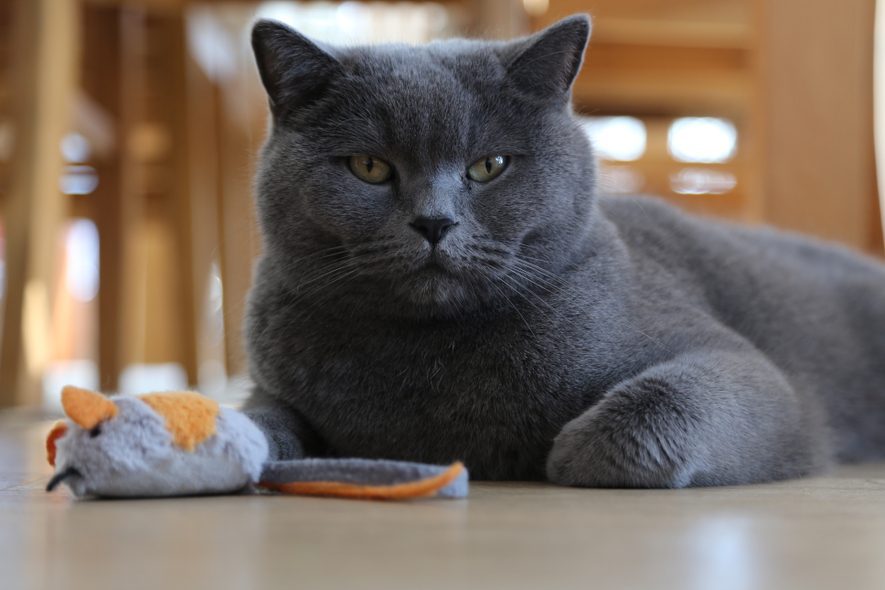
She avoids her favorite mouse toy
Toys can actually be a major source of irritation for a cat, Young says. "They get bored with the same toys, so it's important to mix them up or refresh them with catnip," she explains. "Cats need lots of stimuli because they are natural hunters and love the game of chase and capture." That has to do with their hunting instincts, which is also the reason why cats sleep so much.
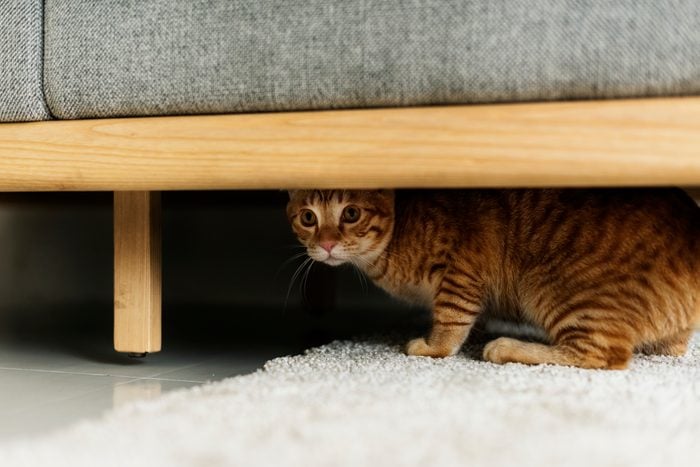
He hides under the couch and refuses to come out
Hiding is one of the first signs your cat is unhappy or fearful of you or the situation, says Amy Shojai, a certified animal behavior consultant and the author of ComPETability: Solving Behavior Problems in Your Multi-Cat Household . Resist the urge to try to drag your angry cat out of hiding—it's a protective reflex, and if you force him to socialize before he's ready he may become aggressive, she explains.
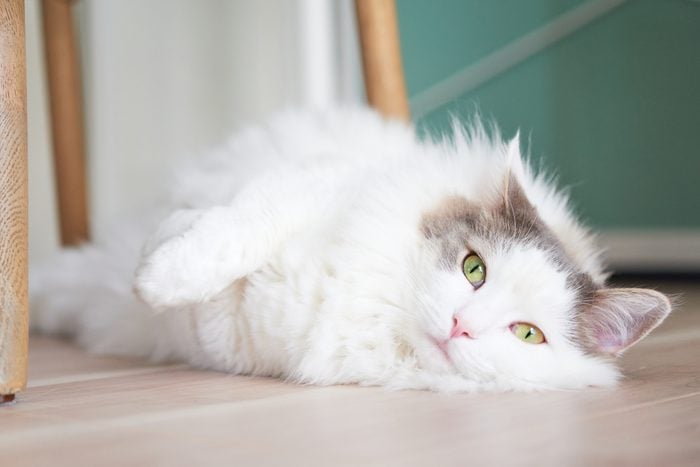
She suddenly gets very fluffy
The very stereotype of an "angry cat" is a kitty crouching with an arched back, fluffed out fur, and a bushy tail, Shojai says. This gives the animal the appearance of being bigger and more intimidating—which often backfires with enamored owners. But no matter how cute or funny you find this posture, now is not the time to try and pet her. Give her space or she may swat at you or bite, she says.
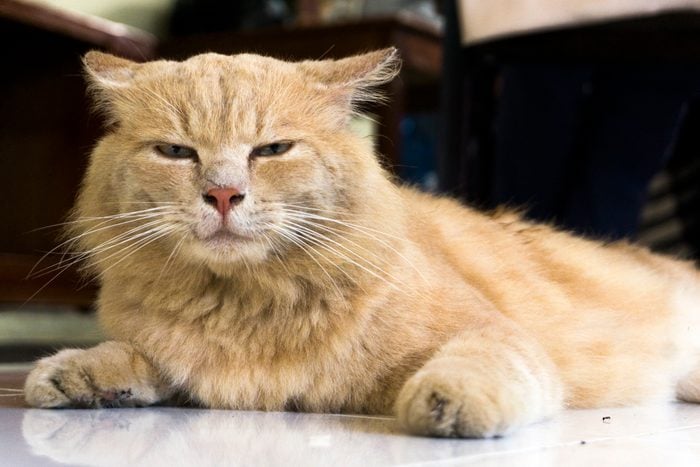
His ears look like he's preparing for takeoff
Ears flattened back against the head and slightly sticking out—"like airplane wings"—are a sure indicator your cat is upset, Shojai says. Don't worry too much but do keep your distance. "An all-out attack toward people isn't terribly common and, when it happens, may actually be a redirected aggression," she explains. "Your cat cannot address the real reason for their angst (that darn squirrel trespassing in their yard!), so instead they nail a human hand that tries to pet when kitty is upset."
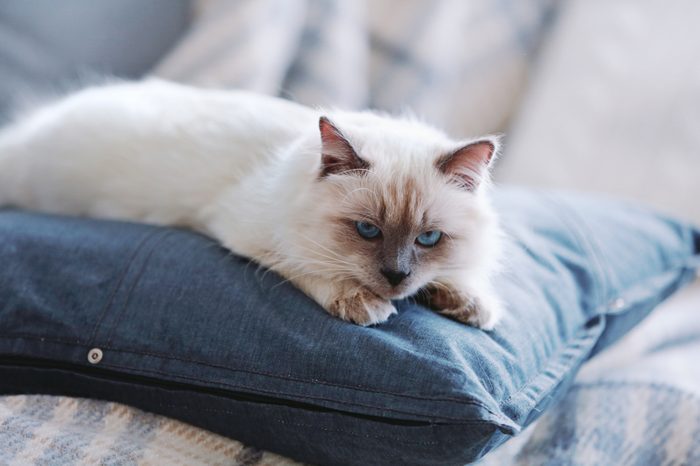
She poops on your pillow
Rare is the cat owner who hasn't discovered a "present" in a surprising place. "Eliminating on your bed is a typical sign of feline separation anxiety," Shojai says. Even though it may appear she's an angry cat taking out her frustrations on you, in reality, she is using her own scent as a way to cope with her anxiety. "That they target the bed is sort of a back-handed compliment, because it smells the most like their beloved—you," she adds. As if that's not enough of a reason, here are 8 more reasons you should never let your cat sleep on your bed.
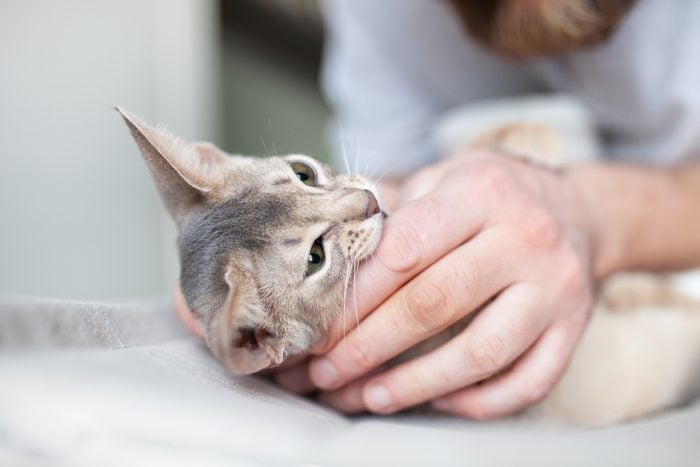
He bites your hand when you pet him
Talk about biting the hand that feeds you! Has your cat ever begged to be petted and then bit or scratched your hand? This is called "petting aggression," and it's totally normal (if annoying), Shojai says. "This 'leave me alone' bite doesn't mean he's angry, but that he wants to control the interaction, and the petting that goes on too long overstimulates him," she explains. This is one of the top things you do that your cat secretly hates.
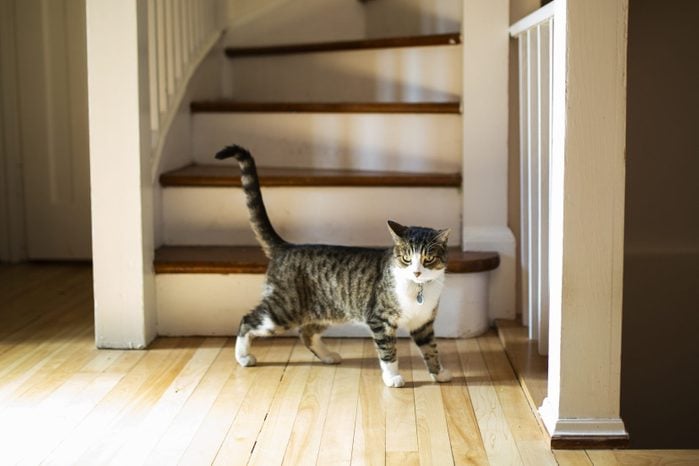
Her tail is all twitchy
One of the first subtle signs that your cat is mad at you is when you see her tail placed low, swishing quickly back and forth, from side to side, says Emily Parker, cat behavior expert at Catological. "Whenever you see the tail twitch, stop whatever it is you're doing that is upsetting her, give her some space, and back off for a while until she calms down," she explains.
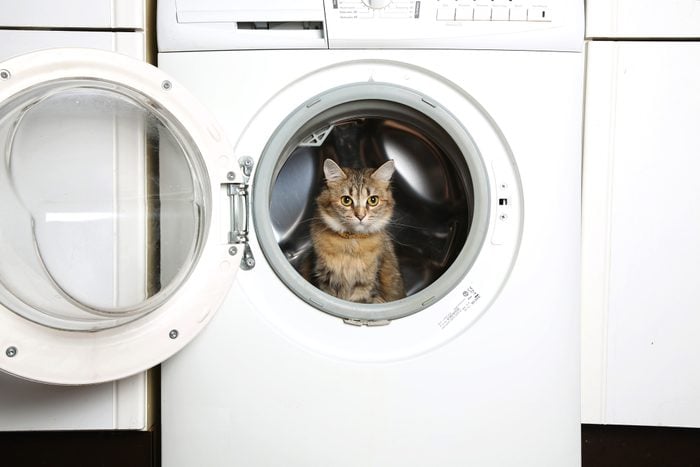
He pees on your clean laundry
Your cat hasn't had an accident since he was a kitten, and now all of a sudden he's peeing all over the house? It's a sure sign he's distressed, says Linda Campbell, a registered veterinary technician specialist in behavior at the Humane Society of Missouri. An angry cat most often urinates on soft surfaces like piles of laundry, sofas, or yes, your bed, she says. It's important to take care of this problem early, before it becomes a habit; talk to your vet if you need help stopping the inappropriate eliminations, she adds. Punishing cats for this type of urination is a common mistake cat owners make.

She refuses her favorite meal
When a cat is upset she may eat less or even refuse to eat at all, Campbell says. Often this is a reaction to a new or unfamiliar situation, a change in routine, or a big event at home, like the birth of a new baby, she says. Keep a close eye on this one, however, as it can also be a sign of illness. If she won't eat for more than a day or two, take her to the vet—it's one of the 11 signs of cat cancer.
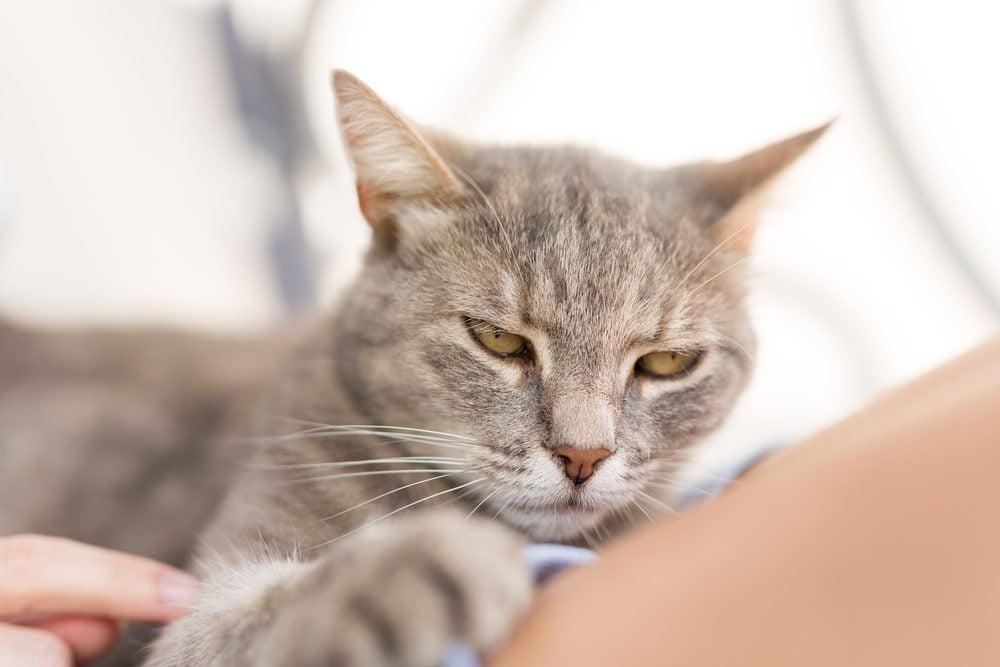
He purrs
Cats purr because they're happy, right? Not always! Purring can also indicate anxiety, fear, or even aggression. If you keep petting a purring cat even after he shows other signs of irritation, you're asking for a swipe or a nip, Campbell says.
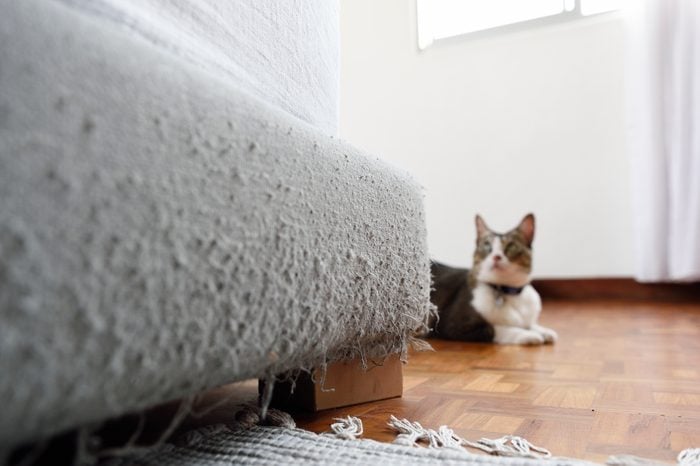
She scratches your furniture
There's nothing more infuriating than an angry cat that looks you straight in the eye, extends her claw, and then swipes at your new leather couch. Rather than aggression or anger, this is more likely due to your cat marking her territory, says Karen Miura, an animal communicator at Whispers from Animals. "Cats are very territorial," she explains. "Cats perceive the house and yard as their kingdom, so things like claw marks on furniture and urine spray on walls are simply fresh boundary lines." She suggests using a cat pheromone spray to help calm things down and save your sofa.
Sources:
- Dawn Kavanaugh, cat behaviorist and CEO of All About Animals Rescue
- Michael Rueb, cat behavior expert and operations manager for the National Cat Protection Society
- Kac Young, PhD, author of The One Minute Cat Manager
- Amy Shojai, certified animal behavior consultant and author of ComPETability: Solving Behavior Problems in Your Multi-Cat Household
- Emily Parker, cat behavior expert at Catological
- Linda Campbell, registered veterinary technician specialist in behavior at the Humane Society of Missouri
- Karen Miura, animal communicator at Whispers from Animals
Originally Published: May 03, 2022
Source: https://www.rd.com/list/signs-your-cat-is-secretly-mad-at-you/
0 Response to "Funny Keep the Cat in the House Sign"
Post a Comment